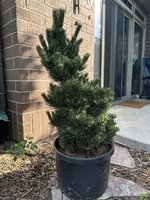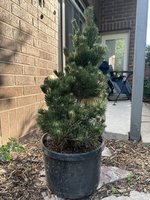ashintz2
Seedling
Hello everyone,
First post after gaining lots of information from browsing these forums for quite awhile! Looking for some advice as I take on a new/unfamiliar bonsai challenge for the first time. Earlier this year I was given a large (at least in relation to other bonsai I've worked with before) Pinus nigra by a family friend that they ended up not using for a landscaping project. For starters I am in the Twin Cities area of Minnesota, USDA zone 5a.
Pictures of the tree from multiple angles are posted below! The tree is currently in a 10 gallon nursery container, the trunk at base near the soil is roughly 2 inches in diameter, and from soil to tip the tree currently stands 36 inches tall. I feel like it has decently dense growth throughout, and the trunk has a nice natural curved shape to it.
When I first received the tree, the root ball was wrapped in burlap that was visible above the soil line. Earlier this year during spring I removed the tree from the container so that I could remove the burlap and found the soil inside to be a very thick, dense clay. I removed the clay from only half of the root ball (figured this would be less stressful) and re-potted back into the same container for the time being and fertilized. I did not do any root work besides removing the clay-like soil during at that time. Besides that I have just let the tree be, and it seems to be doing well!
I understand that this will be a very (very) long project, but because I haven't worked with a tree of this size before, I guess I am just looking to learn and for advice on what to do next.
My ideas for some next steps:
- Remove clay/bare root remaining half of the root ball and replant into a more bonsai friendly soil medium
- Thin out foliage/branches to get a better view of the trunk
- Trunk chop, identify new leader (I am fine if this ends up being a larger/taller tree)
Just curious as to what order would be preferred for the above steps, if there's anything I'm missing and what time of year would be best for each step.
Any advice or insight would be greatly appreciated, thanks in advance!
First post after gaining lots of information from browsing these forums for quite awhile! Looking for some advice as I take on a new/unfamiliar bonsai challenge for the first time. Earlier this year I was given a large (at least in relation to other bonsai I've worked with before) Pinus nigra by a family friend that they ended up not using for a landscaping project. For starters I am in the Twin Cities area of Minnesota, USDA zone 5a.
Pictures of the tree from multiple angles are posted below! The tree is currently in a 10 gallon nursery container, the trunk at base near the soil is roughly 2 inches in diameter, and from soil to tip the tree currently stands 36 inches tall. I feel like it has decently dense growth throughout, and the trunk has a nice natural curved shape to it.
When I first received the tree, the root ball was wrapped in burlap that was visible above the soil line. Earlier this year during spring I removed the tree from the container so that I could remove the burlap and found the soil inside to be a very thick, dense clay. I removed the clay from only half of the root ball (figured this would be less stressful) and re-potted back into the same container for the time being and fertilized. I did not do any root work besides removing the clay-like soil during at that time. Besides that I have just let the tree be, and it seems to be doing well!
I understand that this will be a very (very) long project, but because I haven't worked with a tree of this size before, I guess I am just looking to learn and for advice on what to do next.
My ideas for some next steps:
- Remove clay/bare root remaining half of the root ball and replant into a more bonsai friendly soil medium
- Thin out foliage/branches to get a better view of the trunk
- Trunk chop, identify new leader (I am fine if this ends up being a larger/taller tree)
Just curious as to what order would be preferred for the above steps, if there's anything I'm missing and what time of year would be best for each step.
Any advice or insight would be greatly appreciated, thanks in advance!




